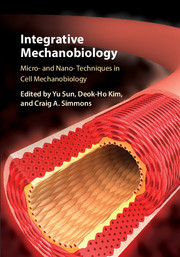Book contents
- Integrative Mechanobiology
- Integrative Mechanobiology
- Copyright page
- Contents
- Contributors
- Preface
- Part I Micro-nano techniques in cell mechanobiology
- 1 Nanotechnologies and FRET imaging in live cells
- 2 Electron microscopy and three-dimensional single-particle analysis as tools for understanding the structural basis of mechanobiology
- 3 Stretchable micropost array cytometry
- 4 Microscale generation of dynamic forces in cell culture systems
- 5 Multiscale topographical approaches for cell mechanobiology studies
- 6 Hydrogels with dynamically tunable properties
- 7 Microengineered tools for studying cell migration in electric fields
- 8 Laser ablation to investigate cell and tissue mechanics in vivo
- 9 Computational image analysis techniques for cell mechanobiology
- 10 Micro- and nanotools to probe cancer cell mechanics and mechanobiology
- 11 Stimuli-responsive polymeric substrates for cell-matrix mechanobiology
- Part II Recent progress in cell mechanobiology
- Index
- References
5 - Multiscale topographical approaches for cell mechanobiology studies
from Part I - Micro-nano techniques in cell mechanobiology
Published online by Cambridge University Press: 05 November 2015
- Integrative Mechanobiology
- Integrative Mechanobiology
- Copyright page
- Contents
- Contributors
- Preface
- Part I Micro-nano techniques in cell mechanobiology
- 1 Nanotechnologies and FRET imaging in live cells
- 2 Electron microscopy and three-dimensional single-particle analysis as tools for understanding the structural basis of mechanobiology
- 3 Stretchable micropost array cytometry
- 4 Microscale generation of dynamic forces in cell culture systems
- 5 Multiscale topographical approaches for cell mechanobiology studies
- 6 Hydrogels with dynamically tunable properties
- 7 Microengineered tools for studying cell migration in electric fields
- 8 Laser ablation to investigate cell and tissue mechanics in vivo
- 9 Computational image analysis techniques for cell mechanobiology
- 10 Micro- and nanotools to probe cancer cell mechanics and mechanobiology
- 11 Stimuli-responsive polymeric substrates for cell-matrix mechanobiology
- Part II Recent progress in cell mechanobiology
- Index
- References
Summary
Human tissues are sophisticated ensembles of various cell types embedded in the complex but defined structures of the extracellular matrix (ECM). ECM is configured in a hierarchical structure from nano- to microscale, with many biological molecules forming large scale configurations and textures with feature sizes up to macroscopic scale (several hundred microns). The physicochemical, biological and mechanostructural properties of native ECM play a critical role in constructing a microenvironment for cells and tissues. In conjunction with the rapid evolution of material science and its fabrication techniques, studies of the topography and elasticity of ECM and other materials have allowed advanced interrogation of cellular mechanotransduction and cellular responses to mechanostructural cues. By learning from and mimicking the highly organized ECM structures found in vivo, topography-guided approaches to regulate cell function and fate have been widely investigated in the last several decades. Here, we review recent efforts in mimicking the micro- and nanotopography of the native ECM in vitro for the regulation of cellular behaviors. We also discuss how these biomimetic topographical surfaces have been applied to fundamental cell mechanobiology studies into cell adhesions, migrations, and differentiation as well as toward efforts in tissue engineering.
- Type
- Chapter
- Information
- Integrative MechanobiologyMicro- and Nano- Techniques in Cell Mechanobiology, pp. 69 - 89Publisher: Cambridge University PressPrint publication year: 2015



